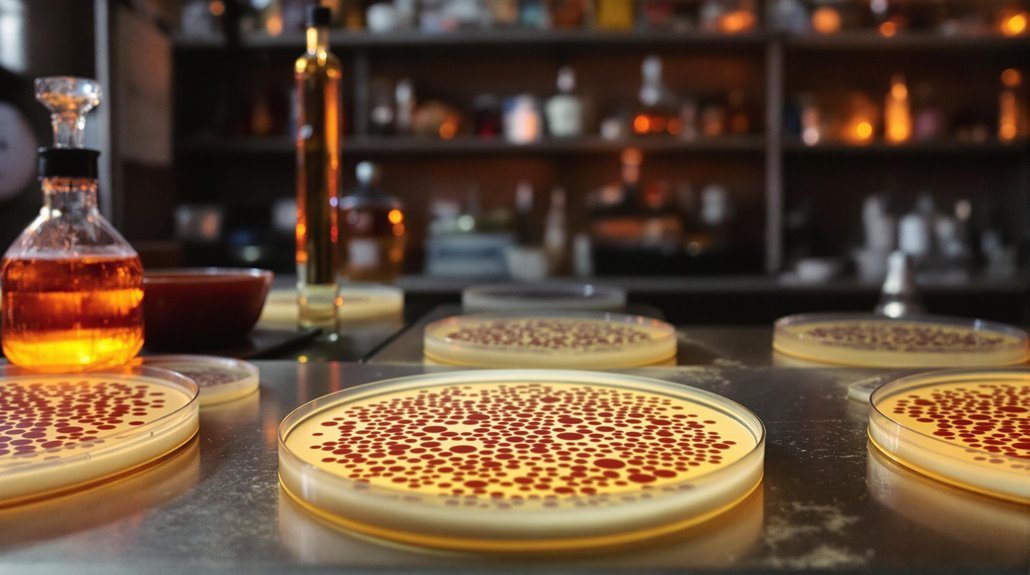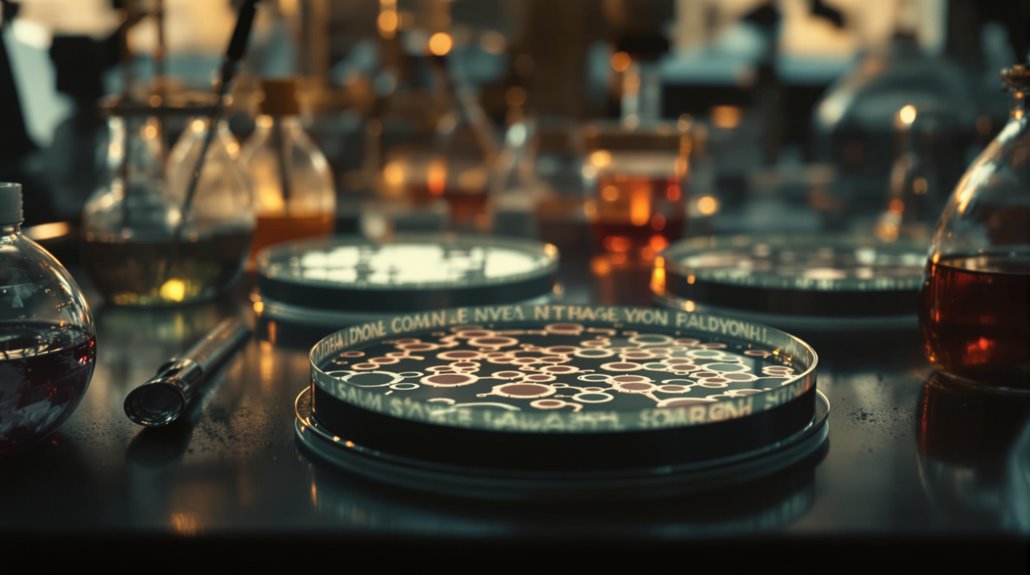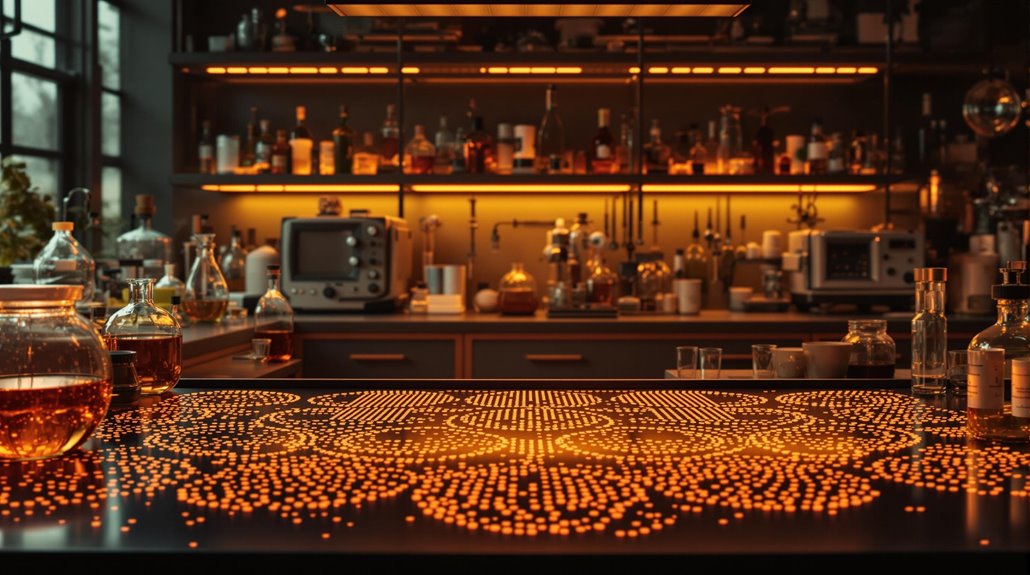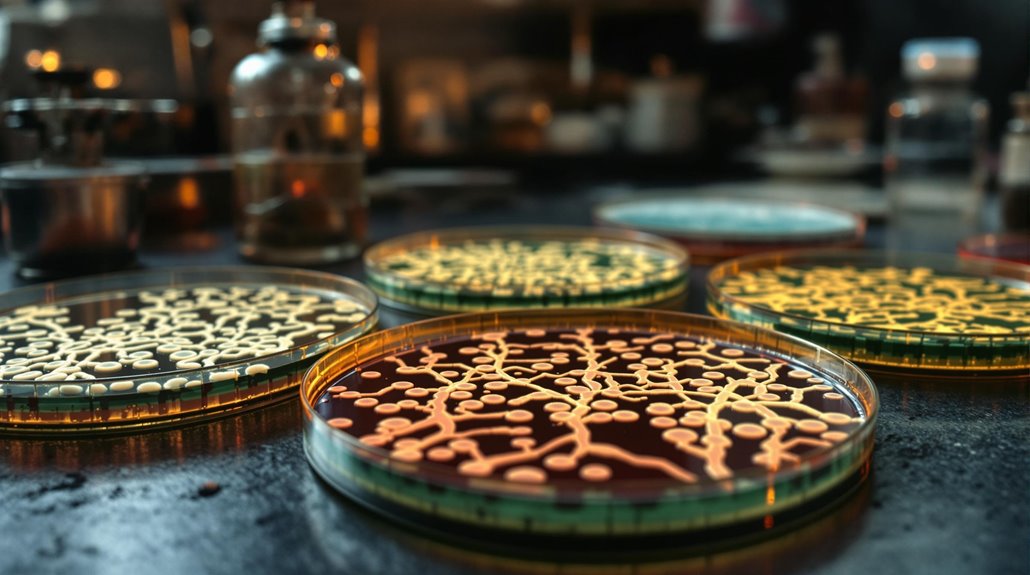Esther Lederberg’s Lab “Stunt”: Growing Bacteria in Patterns to Beat Antibiotic Resistance
You've probably heard about the growing threat of antibiotic resistance, but you might not know about the clever "stunt" that helped scientists understand it. In the 1950s, microbiologist Esther Lederberg developed an ingenious method using nothing more than velvet cloth and precise bacterial patterns. Her simple yet revolutionary technique didn't just change how we study bacteria—it transformed our entire approach to fighting drug-resistant infections. What she discovered in those carefully arranged patterns would reshape modern medicine.
The Mystery Behind Bacterial Growth Patterns

While bacteria may seem to grow randomly, their growth patterns follow precise rules governed by environmental conditions.
You'll find that bacterial morphology changes dramatically based on the environment – from compact colonies in nutrient-rich media to intricate fractal patterns when nutrients are scarce.
Temperature plays a significant role, with different bacteria thriving at specific ranges. You're looking at psychrophiles below 15°C, mesophiles between 20-45°C, and thermophiles above 45°C. Moist and stagnant environments provide ideal conditions for rapid bacterial multiplication.
When you observe nutrient gradients, you'll notice how they shape colony formation: high agar concentration combined with low nutrients leads to branching patterns through diffusion-limited aggregation.
The presence of oxygen, pH levels, and water activity all influence how bacteria grow and spread. Recent studies show bacterial colonies develop into rough broccoli-like shapes as they grow in three-dimensional environments.
Even at the single-cell level, these patterns can be tracked using advanced techniques like time-lapse microscopy.
Understanding Replica Plating: A Revolutionary Method
When Esther and Joshua Lederberg introduced replica plating in 1952, they revolutionized how scientists screen bacterial colonies for genetic traits. Their elegant method uses a simple velveteen-covered disk for colony transfer, allowing you to create exact copies of bacterial arrangements from a master plate onto multiple selective media plates.
The technique emerged after extensive trials with paper and nylon velvet before standardizing on cotton velveteen. This foundational work became essential in genetics for identifying mutations in microorganisms.
You'll find this technique particularly useful when you need to identify specific bacterial characteristics, like antibiotic resistance, without disturbing your original colonies.
By pressing 30-300 colonies from your master plate onto the velveteen and then onto new plates with different selective media, you can efficiently track which bacteria possess the traits you're studying.
This breakthrough approach streamlines the screening process, letting you test multiple characteristics simultaneously while maintaining your original sample intact.
Breaking Down Antibiotic Resistance Myths
Misconceptions about antibiotic resistance continue to hinder our fight against this growing global threat. Through myth debunking, you'll discover that this crisis isn't just a human health issue – it affects animals, plants, and entire ecosystems.
It's not a future problem either; over 35,000 Americans die yearly from resistant infections, with global deaths exceeding 1.27 million in 2019. By 2050, nearly 2 million deaths are expected annually from antibiotic-resistant infections. The economic impact is staggering, with experts projecting healthcare costs of US$1 trillion by 2050.
Resistance awareness reveals that the causes extend beyond human antibiotic overuse. Environmental contamination, agricultural practices, and poor healthcare sanitation all contribute to this crisis.
You're not powerless in this battle – simple actions like proper handwashing, completing prescribed antibiotic courses, and getting vaccinated make a significant difference.
Understanding these realities helps you become part of the solution rather than perpetuating dangerous myths about antibiotic resistance.
The Lambda Phage Connection
Grasping antibiotic resistance took a fascinating turn through Esther Lederberg's groundbreaking discovery of lambda phage in 1950.
Her work revealed how this virus could integrate into bacterial DNA without killing the host cell through a lysogenic cycle, revolutionizing our comprehension of genetic regulation and bacterial evolution. While at the University of Wisconsin-Madison, she made this pivotal discovery that would shape microbiology for decades to come. She established the Plasmid Reference Center to further advance bacterial genetics research.
You'll find lambda phage's impact on antibiotic resistance research particularly compelling through these key insights:
- Demonstrates how bacteria can acquire new genetic material through viral transduction
- Shows mechanisms of DNA transfer between bacterial cells
- Reveals complex regulatory systems within bacterial genomes
- Explains how bacteria adapt and evolve through viral interactions
- Provides tools for studying bacterial gene expression and regulation
This discovery fundamentally changed how we perceive bacterial adaptation and resistance, opening new avenues for combating antibiotic-resistant infections.
From Velvet to Victory: How Simple Tools Changed Science

Through the elegant simplicity of velvet cloth, Esther Lederberg revolutionized microbiology with her replica plating technique in the 1950s.
Drawing inspiration from her father's printing press, she transformed a basic fabric into a powerful scientific tool that could transfer and replicate thousands of bacterial colonies while maintaining their exact positions.
This velvet innovation proved essential for bacterial genetics research, particularly in understanding antibiotic resistance.
You'll find it fascinating that she initially tested the concept using a makeup powder puff before perfecting the technique with specially treated velvet fabric.
The method definitively showed that bacterial mutations occur spontaneously rather than in response to environmental pressures.
After facing financial hardships during her education, she went on to become a respected pioneer in her field.
Today, you'll see Lederberg's technique used worldwide in labs studying everything from gene regulation to bacterial conjugation. Her groundbreaking work, completed during her time at the University of Wisconsin, helped establish her as a pioneer in bacterial genetics.
A Legacy That Shapes Modern Medicine
While many scientists achieved fame during the golden age of molecular biology, Esther Lederberg's groundbreaking discoveries continue to influence modern medicine in profound ways.
 a Stanford professor, she helped establish women's presence in academic microbiology during an era when female faculty were rare. Despite being offered only a research-associate position while her husband led the genetics department, she persevered in her revolutionary research.
a Stanford professor, she helped establish women's presence in academic microbiology during an era when female faculty were rare. Despite being offered only a research-associate position while her husband led the genetics department, she persevered in her revolutionary research.
You'll find her scientific legacy reflected in current medical advances through:
- Lambda phage studies that drive contemporary viral research and therapy
- F factor discoveries that help us understand how bacteria share resistance genes
- Replica plating techniques still used to study bacterial mutations
- Contributions to specialized transduction that inform gene therapy approaches
- Plasmid research that's essential for developing new antibiotics
These discoveries aren't just historical footnotes – they're active tools in modern medicine's arsenal against evolving pathogens.










